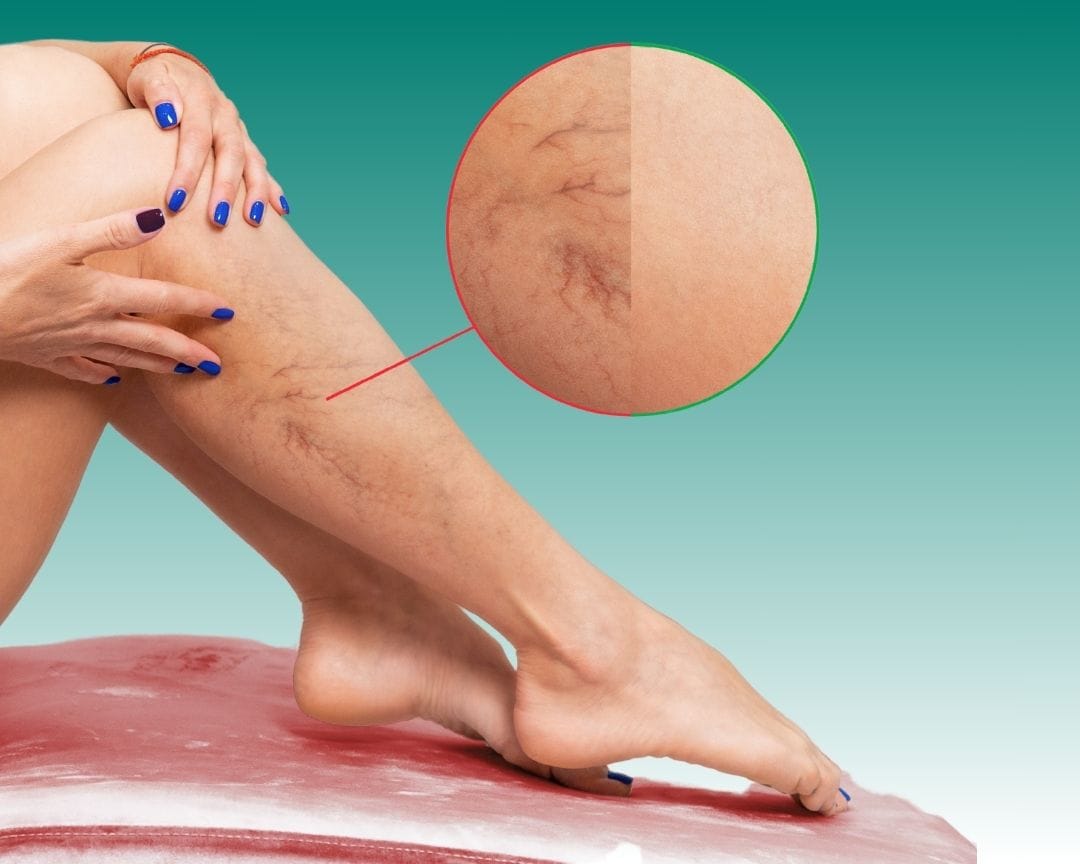Varicose Veins in Turkey
Varicose veins are larger veins that are bulging and enlarged. Any vein located close to the surface of your skin, also known as superficial, can become varicose. Varicose veins most commonly affect the veins in the legs. This is because walking and standing increase pressure in the veins in the lower part of the body.
Many people believe that varicose veins are an aesthetic issue. They are also associated with spider veins, a mild variant of varicose veins. However, varicose veins can cause painful and uncomfortable sensations. Sometimes, they can lead to more serious health issues.
The treatment involves elevating your legs when lying down and wearing compression socks. It is possible to close or eliminate affected veins.
Varicose veins may not cause discomfort. The symptoms include:
- Veins that are dark purple, blue, or match the color of the skin. Based on the color of your skin, these changes can be more or less visible.
- Veins that look curled and bulging, often shaped like cords hanging from the legs.
Signs of painful varicose veins may include:
- Achy or heavy feeling in the legs.
- Throbbing, burning, muscle cramps, and swelling of the lower legs.
- Pain that worsens after standing or sitting for long periods.
- Itching in one or more veins.
- Skin color changes around the varicose vein.
Spider veins look similar to varicose veins, but they are smaller. Spider veins are located close to the surface of the skin and can resemble spider webs. Spider veins are common on the legs but can also be found at the base of the face. They vary in size and resemble a spider’s web.
A damaged or weak valve can cause varicose veins. Blood vessels carry fluid from your heart throughout your body, and veins return blood back to the heart. To bring blood back to the heart, the veins in the legs must function against gravity.
The muscles in the lower leg act as pumps. The vein walls assist in returning blood to the heart. Small valves in the veins open as blood flows towards the heart and close to prevent blood from flowing backward. If these valves are damaged or weakened, blood flow can reverse and collect in the veins, causing them to stretch and bend.
Risk Factors
Two main risk factors for varicose veins are:
- Family history: If other family members suffer from varicose veins, you are likely to as well.
- Obesity: Being overweight puts additional strain on veins.
Other factors that could increase the risk include:
- Age: Aging causes wear and tear on the valves in veins that regulate blood flow. Over time, this wear causes the valves to allow some blood to flow back into the veins, where it collects.
- Sex: Women are more likely to develop varicose veins. Hormones can relax vein walls, so changes in hormones during pregnancy, menstruation, or menopause may contribute. The use of hormone treatments, like birth control pills, can also increase the risk.
- Pregnancy: During pregnancy, the amount of blood flowing through the body increases. This supports the growing baby but may also enlarge veins in the legs.
- Standing or sitting for long periods: Movement helps blood flow.
Complications
Complications of varicose veins are uncommon but may include:
- Ulcers: Painful ulcers can develop on the skin near varicose veins, often around the ankles. A discolored area on the skin usually appears before the formation of an ulcer. Contact your physician immediately if you suspect an ulcer.
- Blood clots: Sometimes veins deep in the legs enlarge, causing swelling and leg pain. Seek medical attention for persistent swelling or pain in the legs, as it could be a sign of a blood clot.
- Bleeding: Rarely, veins close to the skin may rupture, usually causing minor bleeding that still requires medical attention.
- Leg swelling: Long-term varicose veins may cause leg swelling.
Prevention
Improved blood flow and muscle tone can reduce the risk of varicose veins. The same techniques used to manage discomfort from varicose veins can help prevent them from forming. Try these suggestions:
- Avoid wearing heels or tight stockings (apart from compression stockings).
- Change your standing or sitting position frequently.
- Eat a high-fiber, low-salt diet.
- Exercise regularly.
- Elevate your legs when lying down or sitting.
- Maintain a healthy weight.
Diagnosis
To diagnose varicose veins, a healthcare professional examines the patient, which may involve looking at your legs while standing and checking for swelling. You may also be asked about aching or pain in your legs.
Tests
To diagnose varicose veins, a doctor may use a vein Doppler scan. This is a non-invasive test that uses sound waves to assess blood flow through the valves in the veins. An ultrasound of the leg can help identify any blood clots.
Treatment
Treatment for varicose veins may include self-care methods, compression stockings, and surgical procedures. Procedures for treating varicose veins are usually performed on an outpatient basis, meaning you typically return home the same day.
Find out if your insurance company covers varicose vein treatments. If varicose vein treatment is only for aesthetic purposes, it may be considered cosmetic, and your insurance may not cover it.
Self-care
You can try exercising, elevating your legs when lying down or sitting, and wearing compression socks to alleviate the discomfort of varicose veins. Self-care strategies can also help prevent veins from worsening.
Compression Stockings
Wearing compression stockings in the morning is often the first step in treatment. Compression stockings squeeze your legs, helping veins and leg muscles move blood. The amount of pressure varies by type and brand.
Compression stockings are available at pharmacies and medical stores, and prescription-strength stockings are also available. Insurance may cover prescription stockings if your varicose veins cause symptoms.
Surgery or Other Procedures
If self-care and compression stockings don’t help, or if varicose veins worsen, consult a healthcare professional who may recommend surgery or other treatments:
Sclerotherapy
A healthcare professional injects varicose veins with a solution or foam that scars and closes them. Treated varicose veins should fade within a few weeks. Some veins may need multiple treatments. This procedure is done in a healthcare professional’s office without anesthesia.
Laser Treatment
Laser treatment sends strong light waves into varicose veins, causing the vein to gradually fade and disappear. No cuts or needles are used.
Catheter-Based Procedures with Laser or Radiofrequency Energy
This is often used for larger varicose veins. A medical professional inserts a thin tube (catheter) into the enlarged vein, then heats the catheter’s tip with laser or radiofrequency energy. As the catheter is removed, the heat destroys the vein, causing it to collapse and seal.
High Vein Ligation and Stripping
This procedure involves tying off a vein before it joins a deeper vein and then removing the vein through small incisions. It can be done on an outpatient basis.
Ambulatory Phlebectomy
A healthcare professional removes smaller varicose veins through small skin punctures. Only the parts of the leg being pricked are numbed, and this outpatient procedure usually leaves minimal scarring.
Frequently Asked Questions About Varicose Veins
WHAT ARE VARICOSE VEINS?
Varicose veins are visible through the skin and appear generally flat or bulging and raised. However, spider veins are a form of diseased veins. They get their name from its weblike look. Varicose veins, on the other hand, are flesh-colored, bluish, blue or red. They are most often located on the back of the calves or legs, but they may be found anywhere on the body.
WHAT CAUSES SYMPTOMATIC VARICOSE VEINS?
Varicose veins are caused when the valves that move blood through the veins and into the heart have been damaged or fail. The blood does not get to the heart’s pools and causes discoloration, or veins to expand. In the end, there are a variety of risk factors that can cause varicose veins. They include:
Age. Degeneration of the valves naturally occurs as one ages. The valves that are weaker cannot pull blood towards the heart.
Pregnancy. The volume of blood increases, and blood circulation to the pelvis and legs is reduced during the pregnancy. Increases in blood volume and circulation aid the development of the baby.
Obesity. The excess weight puts pressure on veins, which causes them to be more prone to clogging up blood.
Standing or sitting for prolonged periods. Sitting in the same place for a long time impedes blood flow.
Family background. Certain genetic conditions and diseases can affect the vein’s functionality.
The changes in hormone levels can put women at greater likelihood of developing varicose vessels. These kinds of changes usually occur following menopausal changes or when women are taking birth control.
WHAT ARE THE SYMPTOMS OF VARICOSE VEINS?
Varicose vein sufferers typically have no symptoms aside from the appearance of discoloration as well as bulging veins. But, some suffer various symptoms, which include:
Burning and itching
Muscle cramps occur near the veins affected
Discomfort
Long periods of sitting or standing can cause varicose vein pain.
ARE ALL VARICOSE VEINS THE SAME?
Your body is equipped with deep superficial, perforator and vein systems. Each of these systems could be affected by varicose veins, and they can are characterized by a variety of severity. Every patient is different in characteristics, anatomy and conditions, which means that every varicose vein will be different to another.
HOW COMMON ARE VARICOSE VEINS?
Varicose veins are quite common. They affect one three adults. Certain risk factors may increase the likelihood of getting varicose veins as well as spider veins. Varicose is a common condition that causes spider veins on their feet and legs
ARE VARICOSE VEINS A SERIOUS HEALTH CONCERN?
The condition tends to worsen with time, and if untreated, can trigger symptoms. The most severe cases may lead to vein insufficiency, which prevents blood from returning to the heart.
DO ONLY OLDER WOMEN HAVE VARICOSE VEINS?
Any person of any age may develop varicose veins. Women and men in the 20s-90s have suffered from varicose veins. Certain risk factors increase the chance of developing them, such as the age of the person, gender lifestyle, lifestyle, and the history of your family.
HOW DO YOU PREVENT VARICOSE VEINS?
There isn’t a cure-all solution to stop varicose veins but there are steps you can take to reduce the intensity of the symptoms. Regular exercise, eating a healthy diet and avoiding sitting or standing for extended periods of time, maintaining a the weight of your body as well as wearing compression stockings or elevating your leg can all can help reduce the appearance of varicose veins.
WHAT ARE THE COMPLICATIONS ASSOCIATED WITH VARICOSE VEINS?
The decrease in blood flow can lead to numerous potentially serious complications, which include:
Bleeding. The veins affected are weak and damaged. Therefore, when a patient bumps or cuts their leg, bleeding excessively could occur.
Blood clots. The condition, known as blood clots that develop just under the skin, is identified by swelling and pain.
Ulcers. The decreased the flow of blood triggers blood to accumulate and a sore that is painful develops.
Varicose eczema. Itchy, red, irritation of the skin can cause it to crust and blisters develop on the area of concern.
Chronic vein insufficiency. A decrease in blood flow can affect the skin’s function and blood’s ability to exchange oxygen, waste and nutrients.




